Apple orchard farming is a timeless and rewarding venture that combines natural beauty with practical benefits. As a source of fresh, delicious fruit, apple trees offer both sustenance and satisfaction for those who invest in their cultivation. Whether you’re an experienced farmer seeking to expand your operation or a newcomer eager to engage with the land, learning the ins and outs of apple orchard farming can help you maximize your success and enjoy the fruits of your labor to the fullest. This article will guide you through the essential steps of establishing a thriving apple orchard, from selecting the right variety and site to mastering proper care and harvesting techniques.
Selecting the Appropriate Apple Tree Variety
One of the most important aspects of apple orchard farming is selecting the appropriate apple tree variety to plant.
The right variety is vital to achieve good growth and high-quality fruit. When choosing the right apple tree variety, it is crucial to consider factors such as climate, size, and desired taste.
Each apple tree variety has unique characteristics and may be more suitable for specific conditions and purposes.
Climate
Climate plays a significant role in apple tree farming, as some varieties thrive better in specific regions.
- Some apple tree varieties are better adapted to colder climates, like Honeycrisp and McIntosh, whereas others, like Fuji and Granny Smith, require milder climates with abundant sunshine.
- Tree hardiness is an essential factor to consider when choosing a variety for your orchard.
- Hardiness means the tree can withstand cold temperatures, droughts, and various diseases. Consult a local nursery or extension office to determine which varieties can thrive in your region.
Size
Another essential factor to think about when choosing apple tree varieties is their size.
- Apple trees can be grown as standard, semi-dwarf, or dwarf cultivars, depending on the available space in your orchard.
- Standard trees produce more fruit but require more space and maintenance, whereas dwarf and semi-dwarf varieties are smaller and easier to manage.
- Consider the available land when selecting the size of your trees to ensure proper spacing, access to sunlight, and efficient use of resources.
Taste and Purpose
Considering the taste and purpose of the apples is also necessary when selecting an appropriate variety for your orchard.
- Different apple varieties possess distinct flavors and textures ideal for various uses.
- The Golden Delicious and Red Delicious varieties produce soft, sweet apples suitable for fresh eating, while Granny Smith or Pink Lady apples showcase a tart taste ideal for baking, and the Honeycrisp variety appeals with its exceptional storage life.
- Before deciding which varieties to cultivate, identify your target market or intended consumer to providing the most desirable options for their needs.
Pollination
Lastly, pollination is a vital aspect to apple orchard farming.
- Almost all apple tree varieties are self-incompatible, requiring cross-pollination between different varieties to bear fruit.
- Therefore, it is important to include a range of compatible varieties in your orchard to ensure optimal pollination, resulting in an abundant harvest.
- Consult with a local nursery, extension office, or commercial orchardists to determine the best compatible varieties for your chosen apple varieties.
Introduction to Apple Orchard Farming
Starting a successful apple orchard involves careful planning and decision-making. A key step in this process is selecting the proper apple tree variety, keeping in mind factors such as climate, size, taste, and pollination compatibility. Additionally, finding the ideal site for your orchard is crucial in order to ensure optimal growth and productivity of your apple trees.
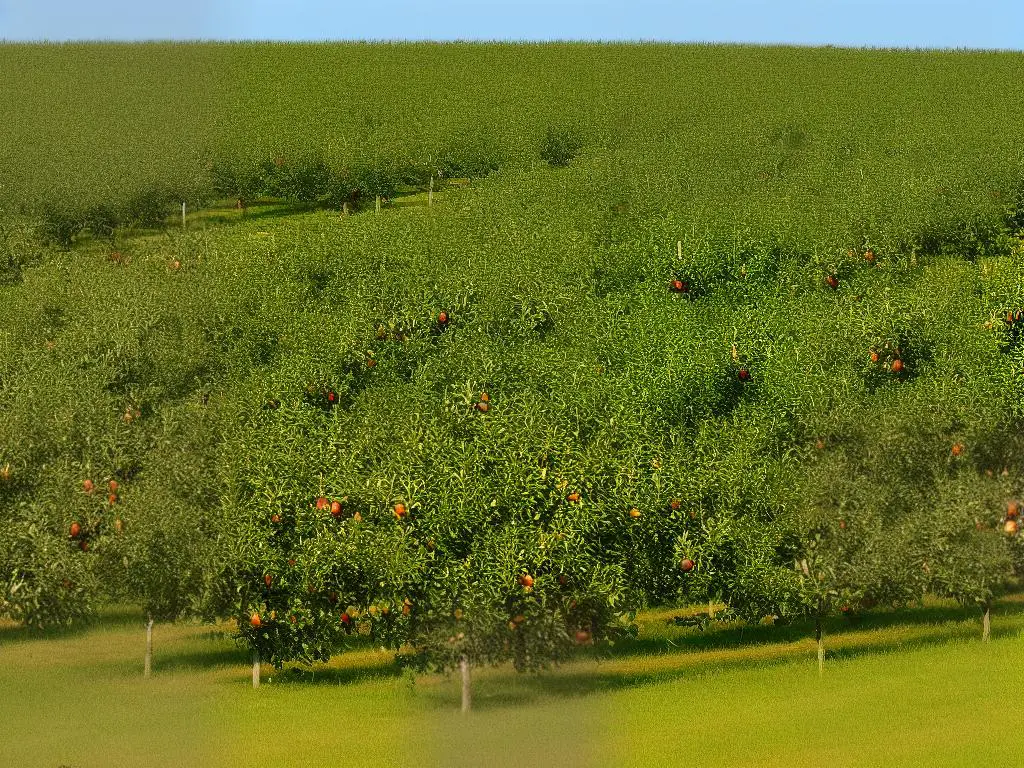
Site Selection
Choosing the perfect location for your apple orchard is of utmost importance. Apple trees require at least six hours of direct sunlight each day in order to thrive and produce quality fruit. Make sure that the chosen site receives ample sunlight throughout the day, without being obstructed by structures or tall, dense vegetation. Moreover, sufficient air circulation is necessary to prevent diseases, so planting trees on a slope or slightly elevated area is preferable, as it helps to avoid low points where cold air may settle during the night. By selecting the right site and apple tree variety, you increase the likelihood of a prosperous apple orchard venture.
Soil Quality
Another critical factor in selecting the perfect site for an apple orchard is the soil quality. Apple trees thrive in well-draining, fertile soil with a pH range between 6.0 and 6.5. To ensure the soil meets these conditions, it is important to test the soil’s pH and fertility levels before planting. This will provide vital information regarding the potential need for amendments to create the most suitable environment for apple tree growth. It is also crucial to avoid low-lying areas or areas with a high water table, as standing water or poor drainage can lead to root rot and other diseases that can be detrimental to tree health.
Preparing the Soil
Preparing the soil for planting is a key step in establishing a successful apple orchard. It is important to begin this process well in advance of planting, ideally in the fall before spring planting. To enhance the soil’s structure and fertility, it may be necessary to add organic matter such as compost, aged manure, or lime to regulate the pH level. Incorporating these amendments into the soil during the fall helps ensure that they have adequate time to break down before trees are planted, maximizing the benefits for root establishment and growth.
In addition to incorporating organic matter, it is also essential to control weeds and prepare a proper planting area for each tree. Weeds compete with apple trees for vital nutrients and water resources, so removing these unwanted plants can help ensure the best possible start for young trees. To prepare each planting site, create a hole that is large enough to accommodate the tree’s root system. This typically requires a hole that is at least twice as wide and as deep as the root ball.
Irrigation Strategy for a Healthy Apple Orchard
Planning and implementing an effective irrigation strategy is an essential aspect of successful apple orchard farming. Often, rainfall alone is not sufficient to meet the water needs of apple trees, especially during the initial establishment phase. Installing a drip irrigation system or using a micro-sprinkler can provide a consistent and controlled water supply, ensuring proper management and maintenance of the orchard’s health. Investing in a well-designed irrigation infrastructure early in the process sets the foundation for a thriving apple orchard in the years to come.
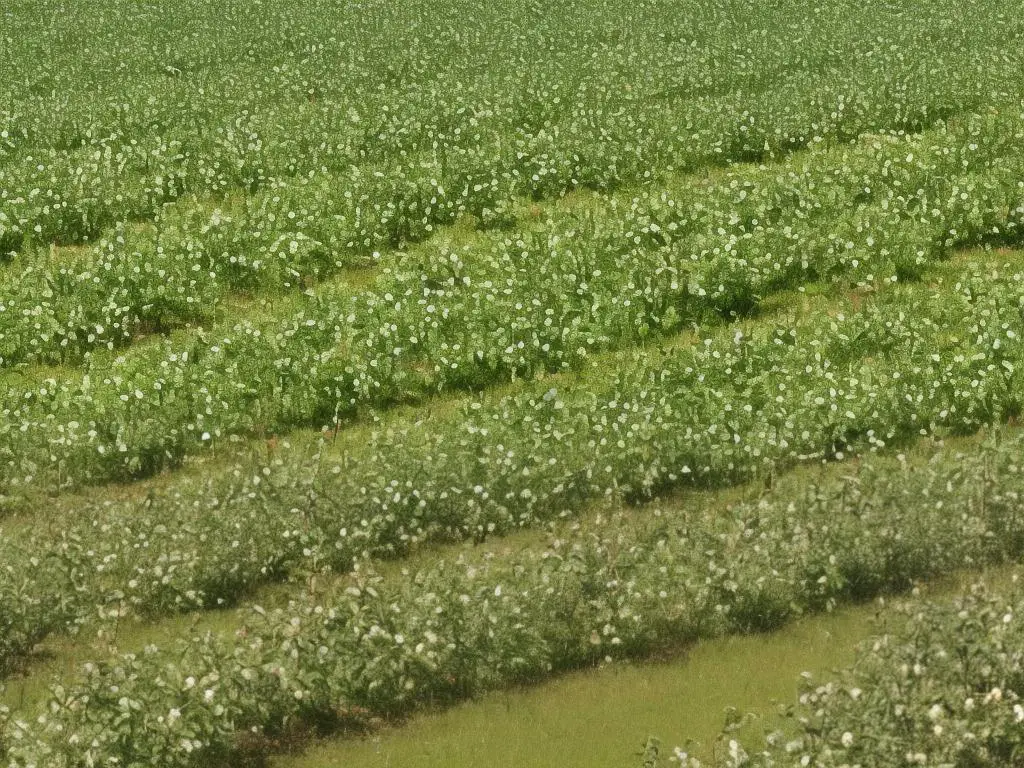
Planting Apple Trees: Timing and Techniques
Once an appropriate irrigation strategy has been established, the process of planting apple trees becomes the next critical step in laying the groundwork for a successful apple orchard. It is important to plan the tree planting according to the dormant season, which generally falls between late fall and early spring. This allows the trees to acclimate to their new environment before resuming growth in spring. Avoid planting during the peak winter months when the ground is frozen or overly saturated. Following these guidelines will ensure healthy growth and productivity for a bountiful apple orchard.
Tree Spacing
Tree spacing is another important aspect of planting apple trees. Proper spacing ensures that trees receive adequate sunlight and air circulation, which are essential for their overall health and fruit production. Apple tree spacing largely depends on the size of the trees and the intended management system. Generally, the rule of thumb is to maintain a distance of 12-15 feet between standard-sized apple trees and 8-10 feet between semi-dwarf trees. Dwarf trees require 4-8 feet of spacing. It’s vital to carefully consider tree spacing since overcrowding can lead to reduced fruit production and increased susceptibility to diseases.
Planting Young Trees
When planting apple trees, ensure the hole you dig is wide and deep enough to accommodate the root system of the young tree. Place the tree in the hole and spread out the roots, with the graft union (where the fruiting variety is grafted onto the rootstock) positioned at least 2-3 inches above the soil line. This helps prevent the grafted variety from developing its roots and allows the tree to benefit from the rootstock’s disease resistance and growth control. Fill the hole halfway with soil, remove any air pockets by tamping down gently, and then finish filling the hole.
Initial Watering and Staking of Apple Trees
Proper watering and staking are essential for the establishment of apple trees in an orchard. After planting, it is crucial to thoroughly water the trees to help the roots settle into the soil. Ensure the entire root zone is saturated, but avoid waterlogging the soil as excessive moisture can lead to root rot. Instead, aim to moisten the soil evenly in the top 12-18 inches. In the first few weeks, monitor the moisture levels and water as needed to maintain consistently moist soil.
Staking is especially beneficial for young apple trees, especially in areas with strong winds or loose soil. By providing necessary support while the roots develop, staking helps the trees establish themselves more effectively. Place stakes at least a foot away from the trunk to protect the roots, and use a tree tie or soft strap material to secure the tree to the stake. This allows for some movement while preventing chafing on the trunk. Regularly inspect and adjust the tie as the tree grows to prevent girdling.

Training and Pruning as an Essential Component of Apple Orchard Farming
In addition to initial watering and staking, tree training and pruning play crucial roles in apple orchard farming, ensuring healthy tree growth and increased fruit production. These practices also help minimize the risk of disease. One widely-adopted training method is the central leader system, which utilizes the tree’s primary trunk as its central support structure. This system promotes an open canopy that allows for optimal sunlight penetration and air circulation, both vital for tree development and fruit quality.
Training Young Trees
Early establishment of tree training systems lays the foundation for efficient pruning throughout the tree’s lifetime. Yearly pruning generally takes place during the dormant season, typically in late winter or early spring. Train young trees by selecting strong scaffold branches with wide crotch angles that radiate evenly around the central leader. These branches should be evenly spaced vertically and well-attached to the central leader, ensuring the tree has a sturdy structure to accommodate a fruit’s weight as it grows.
Maintenance Pruning
Once a suitable structure is established, the focus of tree pruning shifts to maintenance. Pruning a mature apple tree involves the removal of dead, damaged, or diseased wood, thinning out overcrowded or crossing branches, and lightening overly heavy limbs. Removing excess vegetative growth improves the balance between vegetative and reproductive growth, promoting larger, higher-quality fruit. Furthermore, it grants better exposure to sunlight, vital for optimizing photosynthesis and the maturation of fruit.
Summer Pruning
Summer pruning may be advantageous in certain situations, such as for rejuvenating neglected trees or maintaining highly productive dwarf varieties. However, it is essential to approach summer pruning with caution, as excessive removal of foliage can lead to sunburn on the fruits and tree trunk. Diligent monitoring and careful decision-making can result in excellent outcomes for fruit coloring, size, and quality.
Overall
Strategic tree training and consistent pruning practices are integral aspects of apple orchard farming that contribute to healthy and productive trees. Implementing these techniques allows growers to increase fruit yields while simultaneously reducing the risk of diseases. The key to a successful apple orchard lies in striking a balance – allowing the trees to grow and develop while maintaining their ideal structure and maximizing their fruit-producing potential.
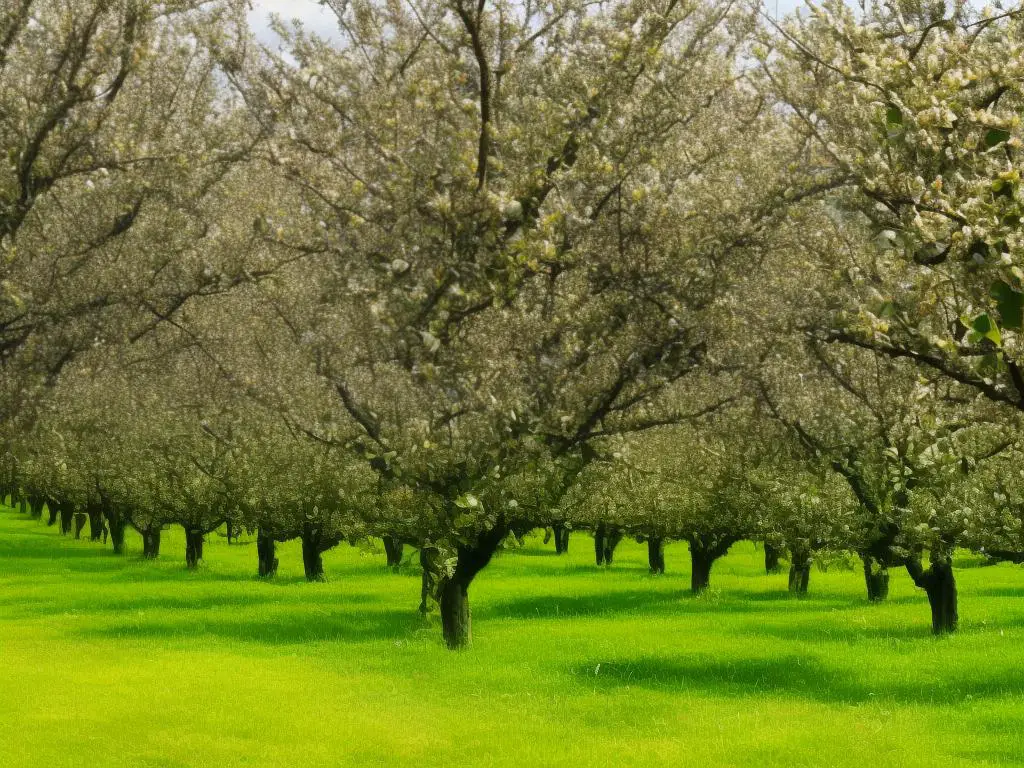
Apple Orchard Management
Another crucial aspect of maintaining a thriving apple orchard is providing the appropriate amounts of water and nutrients for optimal growth and health. Irrigation plays a critical role in apple orchard management, ensuring that trees receive a consistent and adequate supply of water. Factors such as tree age, rootstock, soil type, and climate determine the water requirements for an apple orchard. Generally, apple trees require a steady supply of water throughout the growing season, with an increased need during periods of rapid growth and fruit development.
Irrigation Methods
Selecting the appropriate irrigation method is essential for water management in an apple orchard. There are several irrigation methods, such as sprinkler, drip, and micro-sprinkler systems. Of these methods, drip irrigation is the most efficient, as it helps conserve water by directing it onto the root zone of the trees. Additionally, drip irrigation improves the efficiency of nutrient uptake and aids in preventing weed growth. Micro-sprinkler systems, which distribute water in smaller droplets, are another water-efficient option suitable for apple orchards.
Fertilization
Proper fertilization is another key aspect of apple orchard farming. Apple trees require a specific balance of nutrients, including nitrogen, phosphorous, potassium, calcium, and micronutrients such as boron, zinc, and iron. Nitrogen is the most important nutrient for apple tree growth and fruit development, while phosphorous and potassium are essential for root growth, disease resistance, and overall tree health. Adjusting the fertilization regimen according to soil tests and leaf analysis is essential for ensuring that trees receive the proper balance of nutrients.
Fertilizer Application
Providing appropriate fertilization involves selecting the right type, amount, and timing of fertilizer application. There are various types of fertilizers available, both organic and synthetic, with differing compositions of primary and secondary nutrients. A comprehensive soil test will reveal any nutrient deficiencies in the soil and inform the orchard manager on the appropriate type and amount of fertilizer to apply. Typically, fertilizer is applied during the early spring before the trees begin to show new growth, giving them an initial nutrient boost for the growing season.
Fertigation and its Benefits in Apple Orchard Farming
For an apple orchard to thrive, it is crucial to maximize the benefits of fertigation by integrating irrigation and fertilization systems effectively. Fertigation involves the injection of dissolved fertilizer into the irrigation system, which enables efficient nutrient uptake by the tree roots. This practice offers precise control over the timing and amount of nutrient application, significantly reducing nutrient loss due to leaching and run-off. Moreover, fertigation can be adjusted throughout the growing season to meet the trees’ changing nutrient requirements, ensuring optimal tree health and productivity in apple orchards.
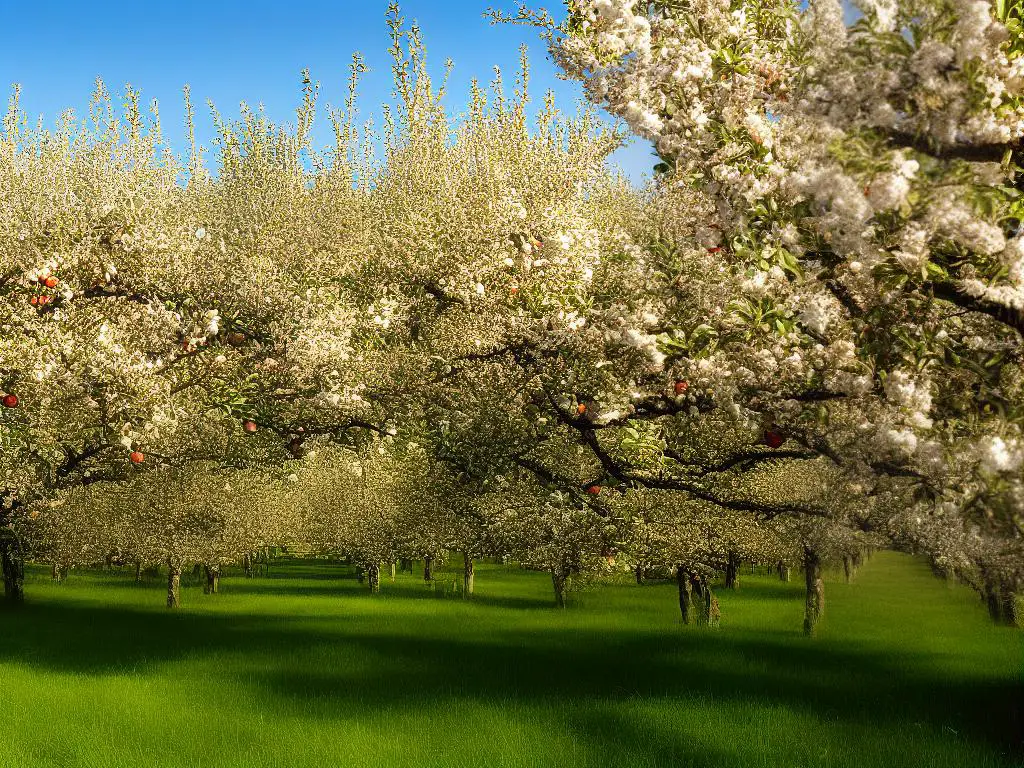
Addressing Challenges in Apple Orchards
However, apple orchards often face numerous challenges concerning pests and diseases that can significantly impact the health and productivity of the trees. Common pests such as codling moths, apple maggots, and aphids frequently attack apple trees, while diseases like fire blight, apple scab, and powdery mildew are quite prevalent. These issues may cause a reduction in fruit quality, tree vigor, and overall yield, making it critical for apple orchard farmers to support effective fertigation practices with a strong pest and disease management plan to ensure the success of their orchards.
Integrated Pest Management
Integrated pest management (IPM) is a critical component of maintaining healthy apple orchards. This approach involves using a combination of cultural, biological, and chemical control methods to manage pests and diseases in a sustainable and environmentally friendly manner. Cultural control practices include selecting resistant varieties, maintaining a healthy orchard environment, and utilizing proper pruning and sanitation techniques. Biological control involves promoting the presence of beneficial insects, such as predatory mites and parasitic wasps, which help to keep pest populations in check.
Chemical control is often necessary to combat pests and diseases in apple orchards effectively. However, it should be used as a last resort and in conjunction with other IPM practices. Selecting the appropriate pesticide and the proper timing of applications are crucial to ensure efficacy. Often, growers will use pheromone traps to monitor for the presence of certain pests, such as codling moths, to determine the optimal timing for pesticide applications.
Monitoring and Identification
In addition to implementing IPM strategies, apple orchard farmers must remain vigilant in monitoring their orchards for signs of pests and diseases. Routine scouting can help in early detection, allowing the grower to address issues before they become unmanageable. Proper identification of pests and diseases is also critical, as different problems may require different treatment approaches. Tools such as mobile apps, extension publications, and local experts can help growers accurately diagnose issues affecting their orchards.
Maintaining Tree Health in Apple Orchards
Ensuring the overall health of apple trees is a vital aspect of apple orchard farming, as healthy trees are more resilient to pests and diseases. Regular soil testing and tree nutrient analysis are essential in monitoring tree health. Providing trees with adequate nutrients and water, as well as applying appropriate soil amendments, can greatly improve tree vigor and defense against potential threats. Additionally, planting cover crops and maintaining a diverse ecosystem within the orchard can promote the presence of beneficial organisms and further improve the orchard’s overall health.
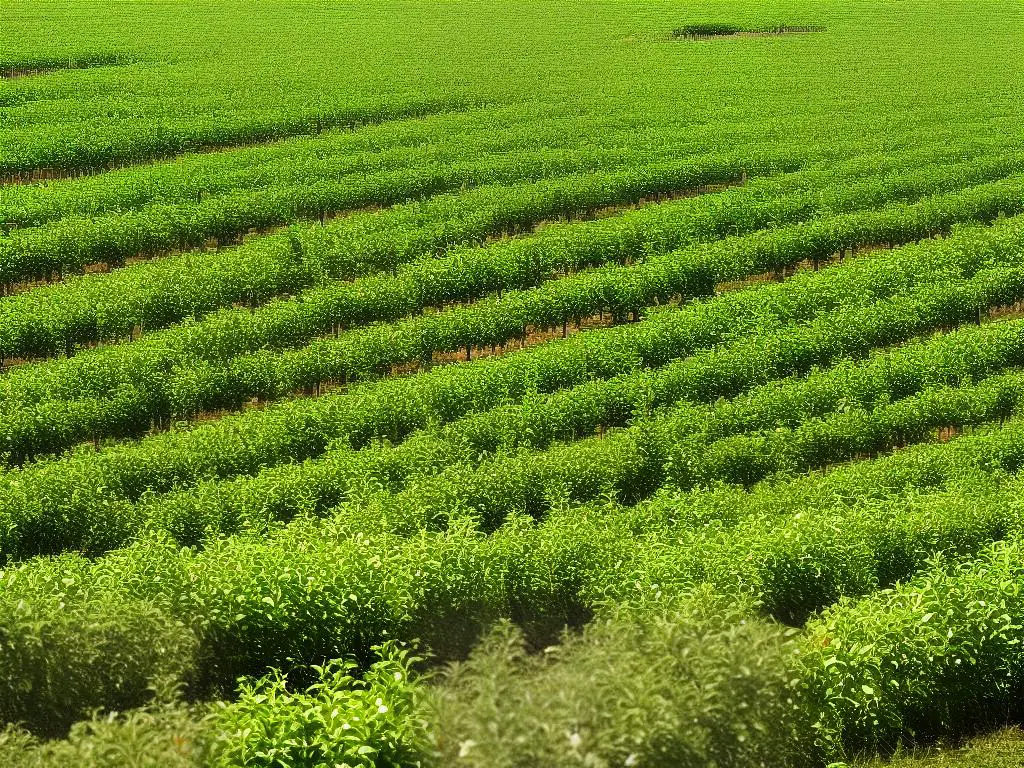
Harvesting and Storing Apples for Optimal Quality
When it comes to apple orchard farming, harvesting apples at the right time is crucial for ensuring their optimal flavor, texture, and storage quality. Each apple variety has specific characteristics that signal when they are ripe and ready for picking. Growers need to be aware of changes in color, firmness, size, and taste. As apples reach their peak maturity, they become sweeter, which can be measured using a refractometer to determine the sugar content, or Brix, in the apples’ juice. By closely monitoring and caring for the health of the apple trees, growers can ensure a successful and abundant harvest, providing delicious and high-quality apples for consumers.
Harvesting Methods
The method used for harvesting apples can impact the quality and shelf-life of the fruit. Many orchards still rely on hand-picking methods, as it allows workers to carefully sort and assess each apple while minimizing bruising. During the picking process, it is essential not to pull the apples straight from the tree; instead, the fruit should be rolled upward off the branch and into the picker’s hand, with the stem remaining intact. The apples are then placed gently into baskets or bags worn by the workers, which helps to minimize dropping or bruising.
Storing Apples
Once the apples are harvested, they must be properly stored to maintain their freshness, crispness, and flavor. The ideal temperature for storing most apple varieties is between 30°F to 32°F, with high relative humidity (around 90%). Apples give off ethylene gas, which causes them to ripen (and subsequently rot) more quickly. Therefore, it is essential to store apples separately from other fruits and vegetables and provide adequate air circulation to slow the ripening process.
In commercial apple orchard farming, the use of controlled atmosphere (CA) storage has revolutionized the way apples are kept fresh for extended periods. CA storage facilities control not only the temperature and humidity but also the levels of oxygen and carbon dioxide in the storage environment. By reducing oxygen levels and increasing carbon dioxide levels, the apples’ metabolism slows down, effectively putting them into a state of hibernation. This process allows growers to store apples for several months while maintaining their crisp texture and juicy flavor.
Conclusion
As consumer demands for high-quality, fresh apples continue to rise, apple orchard farmers must adopt best practices for harvesting and storing their products. Innovations in temperature and atmosphere control technology are continually offering new ways to maintain apple storage quality. By carefully monitoring these conditions, growers will ensure that their apples remain fresh, crisp, and delicious for their customers to enjoy.
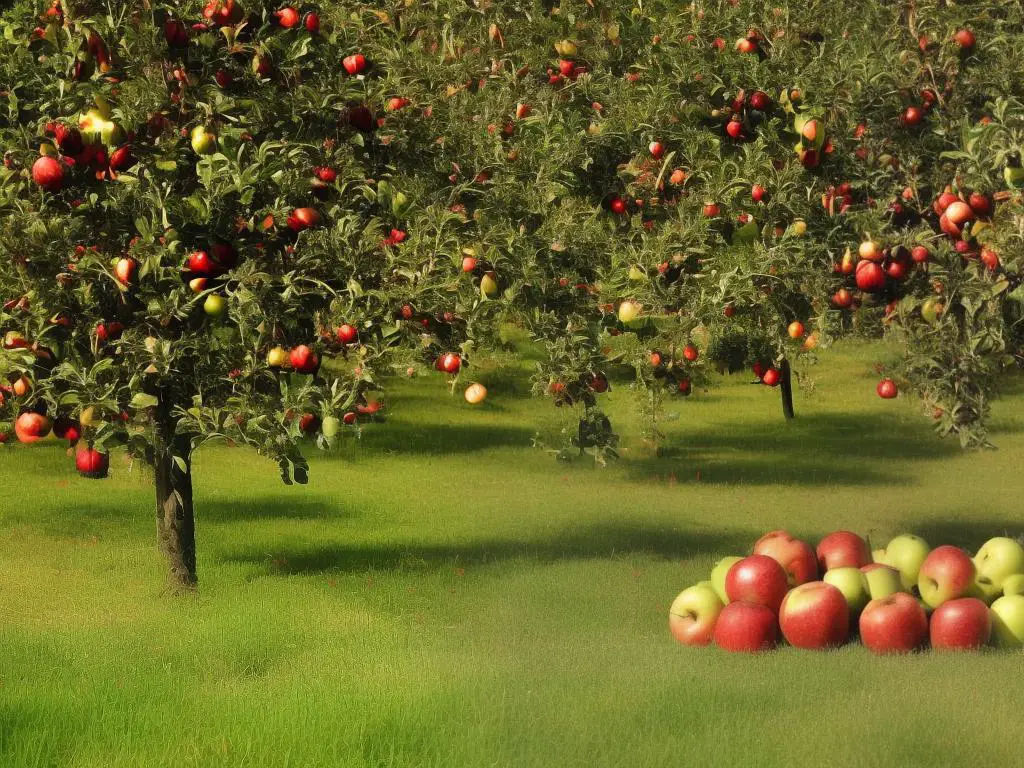
Throughout your journey in apple orchard farming, remember that patience, persistence, and attention to detail are crucial in cultivating a flourishing orchard. By arming yourself with knowledge and consistently applying best practices, you can reap the rewards of your dedication in the form of robust trees and bountiful harvests. Ultimately, apple orchard farming is as much an art as a science, allowing you to experience the manifold joys of connecting with the land and nurturing life. Embrace the challenge, and watch your orchard grow and prosper over time.